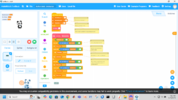If you dont know how to code look into block programming, lots of fun,
easy, and fast to get something working.
An example of debouncing a pin -

mBlock takes you block config and generates the Arduino code from it.
Once you learn a block programmer there are many other variants with common and unique
capabilities, Snap4Arduino, Visuino, Tuniot, Nodered, Flow code, Visuino, some free, other
pay to play.
Some examples :
Micro design has for years relied on ASM and C programming and other languages. Often many tasks are fairly simply but these tools were focused and quite a learning curve, especially ASM and C and C++. There are a number of new GUI based tools that essentially take out the "strong typing"...

www.edaboard.com
Often users, developers, hobbyists need timed and qualified event generators, many resorting to 555 timers and the like. The venerable 555 has had a long run but its limited in accuracy and capability. This approach uses block language to create...
www.electro-tech-online.com
